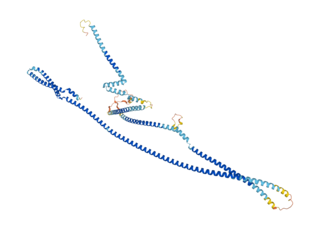
Alternative splicing, or alternative RNA splicing, or differential splicing, is an alternative splicing process during gene expression that allows a single gene to code for multiple proteins. In this process, particular exons of a gene may be included within or excluded from the final, processed messenger RNA (mRNA) produced from that gene. This means the exons are joined in different combinations, leading to different (alternative) mRNA strands. Consequently, the proteins translated from alternatively spliced mRNAs usually contain differences in their amino acid sequence and, often, in their biological functions.

Estrogen receptors (ERs) are a group of proteins found inside cells. They are receptors that are activated by the hormone estrogen (17β-estradiol). Two classes of ER exist: nuclear estrogen receptors, which are members of the nuclear receptor family of intracellular receptors, and membrane estrogen receptors (mERs), which are mostly G protein-coupled receptors. This article refers to the former (ER).

L1, also known as L1CAM, is a transmembrane protein member of the L1 protein family, encoded by the L1CAM gene. This protein, of 200-220 kDa, is a neuronal cell adhesion molecule with a strong implication in cell migration, adhesion, neurite outgrowth, myelination and neuronal differentiation. It also plays a key role in treatment-resistant cancers due to its function. It was first identified in 1984 by M. Schachner who found the protein in post-mitotic mice neurons.

The PAX3 gene encodes a member of the paired box or PAX family of transcription factors. The PAX family consists of nine human (PAX1-PAX9) and nine mouse (Pax1-Pax9) members arranged into four subfamilies. Human PAX3 and mouse Pax3 are present in a subfamily along with the highly homologous human PAX7 and mouse Pax7 genes. The human PAX3 gene is located in the 2q36.1 chromosomal region, and contains 10 exons within a 100 kb region.

The nuclear receptor 4A1 also known as Nur77, TR3, and NGFI-B is a protein that in humans is encoded by the NR4A1 gene.

Retinoic acid receptor alpha (RAR-α), also known as NR1B1 is a nuclear receptor that in humans is encoded by the RARA gene.

Lysophosphatidic acid receptor 3 also known as LPA3 is a protein that in humans is encoded by the LPAR3 gene. LPA3 is a G protein-coupled receptor that binds the lipid signaling molecule lysophosphatidic acid (LPA).

Collagen alpha-3(IV) chain is a protein that in humans is encoded by the COL4A3 gene.

GATA3 is a transcription factor that in humans is encoded by the GATA3 gene. Studies in animal models and humans indicate that it controls the expression of a wide range of biologically and clinically important genes.

Upstream stimulatory factor 1 is a protein that in humans is encoded by the USF1 gene.

Cux1 is a homeodomain protein that in humans is encoded by the CUX1 gene.

Retinol binding protein 1, cellular, also known as RBP1, is a protein that in humans is encoded by the RBP1 gene.

Cellular retinoic acid-binding protein 1 is a protein that in humans is encoded by the CRABP1 gene.

Folate receptor beta is a protein that in humans is encoded by the FOLR2 gene.

Opioid-binding protein/cell adhesion molecule is a protein that in humans is encoded by the OPCML gene.
Folate targeting is a method utilized in biotechnology for drug delivery purposes. This Trojan Horse process, which was created by Drs. Christopher P. Leamon and Philip S. Low, involves the attachment of the vitamin, folate, to a molecule/drug to form a "folate conjugate". Based on the natural high affinity of folate for the folate receptor protein (FR), which is commonly expressed on the surface of many human cancers, folate-drug conjugates also bind tightly to the FR and trigger cellular uptake via endocytosis. Molecules as diverse as small radiodiagnostic imaging agents to large DNA plasmid formulations have successfully been delivered inside FR-positive cells and tissues.
Membrane progesterone receptors (mPRs) are a group of cell surface receptors and membrane steroid receptors belonging to the progestin and adipoQ receptor (PAQR) family which bind the endogenous progestogen and neurosteroid progesterone, as well as the neurosteroid allopregnanolone. Unlike the progesterone receptor (PR), a nuclear receptor which mediates its effects via genomic mechanisms, mPRs are cell surface receptors which rapidly alter cell signaling via modulation of intracellular signaling cascades. The mPRs mediate important physiological functions in male and female reproductive tracts, liver, neuroendocrine tissues, and the immune system as well as in breast and ovarian cancer.
GT198 is a human oncogene located within the BRCA1 locus at chromosome 17q21. It encodes protein product named GT198, Hop2 or TBPIP. The GT198 gene is found to be mutated with its protein overexpressed in human cancers including breast and ovarian cancers.

Steroid Receptor Associated and Regulated Protein (SRARP) in humans is a protein encoded by a gene of the same name with two exons that is located on chromosome 1p36.13. SRARP contains 169 amino acids and has a molecular weight of 17,657 Da.

Transmembrane protein 101 (TMEM101) is a protein that in humans is encoded by the TMEM101 gene. The TMEM101 protein has been demonstrated to activate the NF-κB signaling pathway. High levels of expression of TMEM101 have been linked to breast cancer.





















